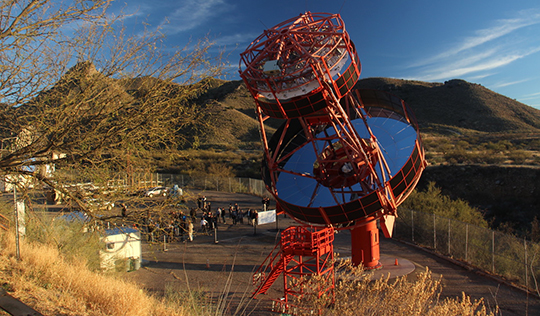 On 18 January, at the Whipple Observatory in Amado, Arizona, pSCT (prototype of the Schwarzschild-Couder Telescope), a prototype telescope for gamma-ray astronomy, which will begin to take data in the coming months, was inaugurated. The aim of pSCT is to provide indications for the construction of the medium-sized telescopes that will be part of the Cherenkov Telescope Array (CTA), the next-generation distributed observatory for gamma photons, in which Italy is participating with INFN and INAF, National Institute of Astrophysics, dedicated to the study of the universe at high energies.Unlike classic gamma ray telescopes traditionally consisting of a single surface of mirrors, SCT telescopes are medium-sized telescopes consisting of two mirror surfaces: the first consisting of 48 and the second of 24 aspherical mirrors. The innovative features of these telescopes will allow CTA to drastically improve the image quality of large regions of the sky and to improve the detection of weak astronomical sources. The CTA involves more than 1,400 scientists and engineers from 31 countries in the scientific and technical development of the highest energy and most sensitive high-range gamma-ray observatory in the world, with approximately 120 telescopes of three different sizes, divided between two sites: one in the northern hemisphere at the Roque de los Muchachos Observatory in the Canary Islands, and the other in the southern hemisphere near the existing site of the Southern Observatory of Paranal, in Chile. Once completed, CTA will allow investigation of the most violent astrophysical phenomena that take place in our universe, but it could also acquire valuable information on aspects that are still little known or even unknown, such as the nature of dark matter, which constitutes most of the existing matter in the cosmos.
On 18 January, at the Whipple Observatory in Amado, Arizona, pSCT (prototype of the Schwarzschild-Couder Telescope), a prototype telescope for gamma-ray astronomy, which will begin to take data in the coming months, was inaugurated. The aim of pSCT is to provide indications for the construction of the medium-sized telescopes that will be part of the Cherenkov Telescope Array (CTA), the next-generation distributed observatory for gamma photons, in which Italy is participating with INFN and INAF, National Institute of Astrophysics, dedicated to the study of the universe at high energies.Unlike classic gamma ray telescopes traditionally consisting of a single surface of mirrors, SCT telescopes are medium-sized telescopes consisting of two mirror surfaces: the first consisting of 48 and the second of 24 aspherical mirrors. The innovative features of these telescopes will allow CTA to drastically improve the image quality of large regions of the sky and to improve the detection of weak astronomical sources. The CTA involves more than 1,400 scientists and engineers from 31 countries in the scientific and technical development of the highest energy and most sensitive high-range gamma-ray observatory in the world, with approximately 120 telescopes of three different sizes, divided between two sites: one in the northern hemisphere at the Roque de los Muchachos Observatory in the Canary Islands, and the other in the southern hemisphere near the existing site of the Southern Observatory of Paranal, in Chile. Once completed, CTA will allow investigation of the most violent astrophysical phenomena that take place in our universe, but it could also acquire valuable information on aspects that are still little known or even unknown, such as the nature of dark matter, which constitutes most of the existing matter in the cosmos.






